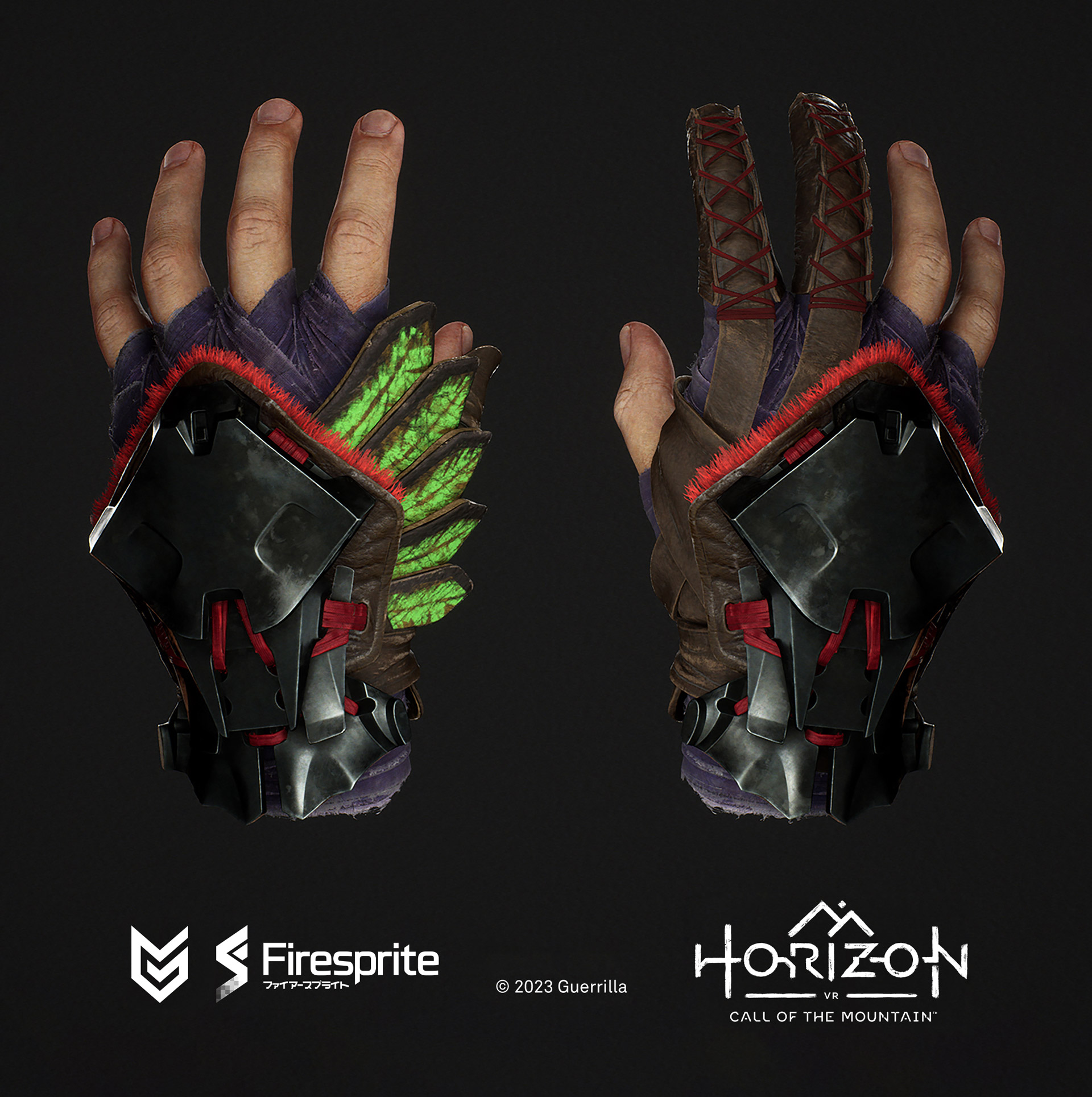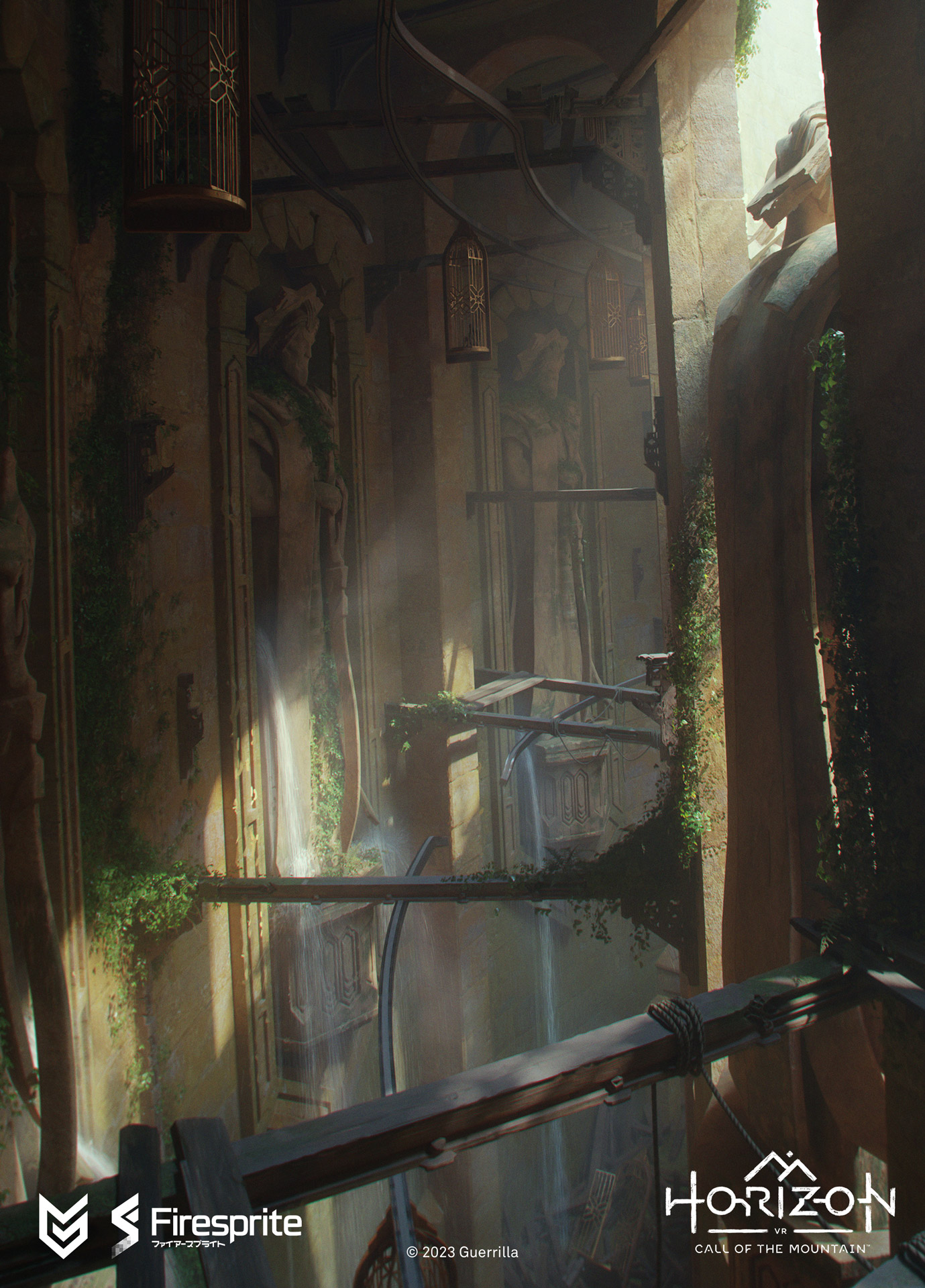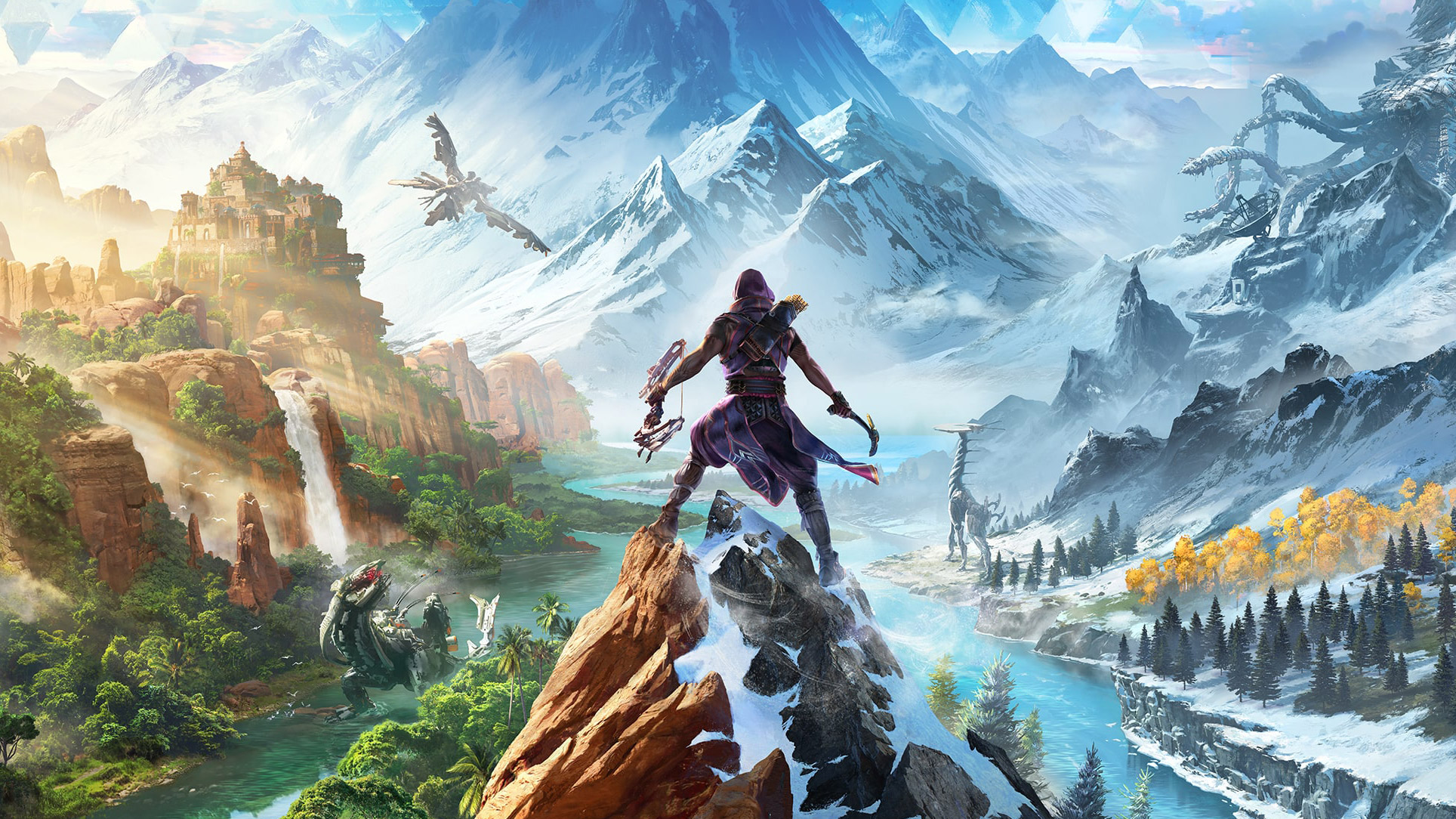It’s a rare treat when we get a VR game with the scope and scale of Horizon Call of the Mountain, let alone to see a much-loved IP reimagined specifically for the medium. Made exclusively for PSVR 2, the game was built collaboratively between studios Guerrilla Games and Firesprite, both part of PlayStation Studios. We sat down to speak with Alex Barnes, Game Director at Firesprite, to learn more about how Horizon Call of the Mountain came to be and how it turned out to be one of our best-rated VR games in recent memory.
Editor’s Note: The exclusive artwork peppered throughout this article is best viewed on a desktop browser with a large screen or in landscape orientation on your phone. All images courtesy Guerrilla Games & Firesprite.
Gameplay clips may not appear with cookies disabled, click ‘View clip’ to see them in a separate window.
Moving a Mountain
Horizon Call of the Mountain is, of course, a Horizon game. With that, comes the expectation that it will look, feel, and sound like the other two titles in Guerrilla’s lauded franchise. That meant the two studios had to work in close collaboration to deliver on the vision.
“Call of the Mountain was an incredibly collaborative project, with both Firesprite and Guerrilla working really closely to develop the game, Barnes explains. “The bulk of the content creation and gameplay teams were over with Firesprite, with Guerrilla holding the original vision for the game and helping direct elements, such as the narrative and art, to create a game that was genuinely grounded in the world of Horizon. We had folks from both teams hands-on at different times and were in constant communication with each other throughout development.”
Even though the game would need to be built as a VR native title, the studios wanted to ensure that it represented elements of a Horizon game, without being too attached to every Horizon gameplay trope regardless of whether or not they fit within VR.
“The core of the gameplay was pretty set from the initial idea for the game. We wanted climbing, crafting, exploration, interaction and combat to be the mainstay of everything that we built. That meant freedom of movement and ‘real-feel’ physical interactions like climbing and bow combat were so crucial that we got feeling great for all types of players,” Barnes say. “Early on, we did look into doing some more wide-ranging gameplay elements to descend from the mountaintops, but ultimately these elements really ended up distracting from the overall gameplay experience, so they didn’t make their way into the released game.”
The bow is central to the game’s combat, so the teams gave it tons of interesting detail. | View clip
Come One, Come All
Another important goal was building a game that anyone could play—whether experienced with VR or not—and to leave a real impression.
“We knew this could be players’ first experience with PSVR 2 and, in some cases, even with VR. That meant building gameplay systems that people could just pick up, play and quickly understand so that we could fully immerse the player in the world,” Barnes says. “We are also big lovers of VR ourselves, and so it became a goal of everyone to blow new players away to show them how amazing a truly VR experience is, especially on this incredible new hardware.”
Building for experiences and new VR players alike also meant rethinking the options for how people would move in the game. This was also driven by the developers themselves, some of which couldn’t tolerate much traditional stick movement in VR. This pushed the studio to come up with an ‘arm-swinger’ locomotion scheme which I personally felt was both more comfortable and more immersive than pure stick-motion.
“Comfort in VR is an incredibly personal thing, and locomotion is such a big part of that. For some of the team, the stick-based movement was difficult to get comfortable with. So the motion mimetic system of moving the player’s arms was conceptualised as a way to help add a layer of comfort that allowed people who were less familiar with VR to play for longer and stay comfortable whilst they did,” says Barnes.

Continue on Page 2: For Fun’s Sake »
,
For Fun’s Sake
While the core gameplay of climbing, crafting, and combat were on the map from the start, the studios leaned into richer VR interactions after observing how much players were responding to it. That’s how the game ended up with an impressive set of objects to pick up, throw, smash, or just fiddle with—something that really benefited the game’s immersion.
“I think the playfulness of everything really emerged from the team and user testing through development. Players wanted to pick up and touch everything, so we started building out a world where that was not only possible but encouraged. Elements such as the musical instruments got lots of focused love and attention from the team, and it grew from the team playing, and they were a lot of fun to make.”
The developers provided plenty of optional fun in the form of VR interactions that weren’t core to the gameplay but were a joy nonetheless.
One of the goals of Call of the Mountain was to blow people away with a beautiful virtual world (which game undoubtedly achieves) which is something that just wouldn’t be powerful without a headset that’s backed by something as powerful as PS5. Barnes describes the platform as freeing for the first time, rather than restrictive, when it came to pushing VR visuals.
Call of the Mountain is flush with incredible environmental art, giving players a look at perhaps the best graphics in any VR game to date
“[The teams] leveraged every bit of expertise and experience they had and worked really closely with the incredible engineers behind the PS VR2 to deliver something that dropped my jaw the first time I saw everything come together. The hardware features like eye-tracking, and the power of the PS5 itself opened a lot of doors that were shut to us on our previous VR titles like The Persistence. We could actually start turning the dial the other way for the first time—where we could add things rather than needing to strip them back all the time.”

The Body Language of Annoyance
Call of the Mountain has tons of impressive details, but there was one aspect that’s state-of-the-art in its own small way: the game’s aptly named ‘flinch and lean’ system which gave NPCs dynamic reactions to player annoyances. This isn’t the first VR game with NPCs that react if you touch them, but the specific details of how this system works—the way the NPCs seem truly annoyed at you—while not interrupting their captured performances, is next-level compared to anything I’ve seen in VR to date.
This doesn’t read quite as well if you aren’t seeing this in the headset for yourself, but the NPC’s body language projects true annoyance when you get in their space… to the point that you might think you should apologize.
I asked Barnes to talk about this part of the game in detail:
So what we referred to internally as the ‘flinch and lean’ system was one of those beautiful and funny elements that came from seeing what we were trying to do in the scenes and the team wanting to push what was possible in VR. We really didn’t want to take away the players’ ability to have their hands and full control of their camera in as many scenes as possible, so we didn’t have any jarring disconnects. This naturally meant that we had the ability to wave our hands in the characters’ faces and try to boop their noses!
When we saw players doing this as well, we started to think about ways we could make those moments dynamic, so it became a fun moment instead of something that broke immersion when the characters didn’t react. However, we still wanted the dialogue to be delivered as it had been shot, as we wanted to respect our actors’ performances, not detract from them with noticeable additive animations.
So we set the tech animation and animation teams a challenge to see what we could do to make the characters react dynamically, changing their behaviour based upon the players’ actions. It was a balancing act between the intended motion capture performance and natural reactions. It started as basic movements leaning away from an intrusion in the characters’ space, such as when you poke at them, and it developed from there. Layering in natural reactions to these things came next, such as glances at incoming objects, blinking when you turn to look at something and glancing back at the player because they are instigating the action.
Finally, adding an emotional element with facial reactions to the intrusions coupled with natural eye saccades and a dynamic eye-tracking system that allowed the characters to follow the player camera with their eyes. It was an incredible process that involved lots of research, reference, feedback and some incredibly talented teams to develop something truly innovative.
Continue on Page 3: Next-gen Crafting »
